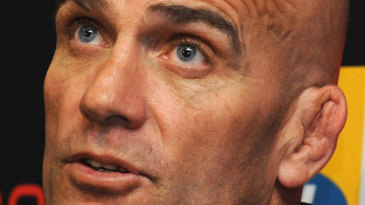
- Drivers:
- Christian Horner
- |
- Adrian Newey
- |
- Sebastian Vettel
- |
- Mark Webber
- Teams:
- Red Bull
Never judge a book by its cover. It's a useful idiom in life and one that quite literally applies to Haynes Owners' Workshop Manual for the Red Bull Racing RB6.
For those who don't tinker with their cars at the weekend, the Haynes publishing company is renowned for producing in-depth general maintenance and repairs manuals for most of the UK's best-selling cars, and has done so for the past 50 years or so. The prospect of a similar manual on last year's championship-winning RB6 is therefore a mouth-watering prospect for rival designers and fans alike, but rather predictably the inner-workings of Adrian Newey's genius have not been laid bare for a recommended retail price of just £19.99.
For all but the most naïve that will come as no surprise, as many of the secrets behind the RB6 are still relevant to the current RB7, which Newey has described as a "further evolution of the current line," adding that the "DNA of the car has been maintained." As a result the secrets behind Red Bull's pace remain locked up in Milton Keynes, and instead this book acts as a general overview of a Formula One car. But that doesn't mean it's a dull read, and it's very likely that you'll learn something new about the technical side of F1 by flicking through its pages.
The book is divided into sections outlining the anatomy of the RB6, including chapters on the chassis, aerodynamics, electronics, the engine and so on. As mentioned above, none of these sections really explain why the RB6 is such a brilliant car, but they do provide a general understanding of each area and are illustrated with close-up photos and diagrams.
Highlights include one of the best explanations available of how the F-duct - last year's must-have technology - worked, as well as the basic principles behind double diffusers, exhaust-blown diffusers and the reasons why Red Bull run a lot of rake from front to rear. If reading that last sentence sent you to sleep then this book is probably not for you, but judging by some of the intelligent questions we receive about the technical side of F1 from readers of ESPNF1.com, there is definitely an audience for this kind of material.
One criticism of the book is that these points of interest are often buried behind fairly bland introductions to each chapter that will cause some readers to switch off. All too often you find yourself scanning through the text rather than absorbing every word, although this is inevitable in a book that is pitching itself at as wide an audience as possible. When you do reach the interesting nuggets of information they often appear too brief, but no doubt that is largely to protect the secrets behind Red Bull's success - a factor the very knowledgeable author acknowledges in the introduction.
For example, some of the pictures used to illustrate the car are from the less successful 2008 RB4 in order to keep the details of the team's pull-rod rear suspension and gearbox casing underwraps. More than anything this proves just how sensitive that area of the car is, and the secrecy will come as no surprise to fans who have witnessed five mechanics guarding the rear of the car from prying eyes at each grand prix.

It also highlights how much of a balancing act car performance is. For example, we all accept that some cars are better at riding bumps and kerbs than others but the reasons for that are very rarely explained. In the chapter on car setup, head of car engineering Paul Monaghan does just that: "If the aero team can create a front wing, or a rear diffuser, which is reasonably insensitive to ride height, that essentially means that you can allow the car to move up and down a lot, because the aero is not sensitive to vertical movement. This in turn means that you can soften the suspension to enable the car to run over kerbs well. If the car has to be nailed to a particular ride height because the aerodynamics fall apart if the car moves about, then you have to run very stiff springs, which means that the car clatters over kerbs and flies in the air. If you can have a car that can be run soft enough to benefit from running over kerbs to shorten the circuit, but still not lose all its downforce when running on the [smooth] track, then it will help lap time and you're in pretty good shape." It may seem pretty simple, but it goes some way to explaining why some updates that improve overall downforce might not actually translate in to significantly quicker lap times and why some cars are better suited to street tracks than others.
As a basic guide to understanding the performance of a Formula One car the RB6 Haynes manual is one of the best books on the market. It answers a lot of common questions about the technical side of the sport and will no doubt enhance your understanding and your viewing pleasure from the armchair. If, however, you have an actual RB6 in your workshop (as the title suggests), it could fall a little short…

Title: Red Bull Racing F1 Car 2010 (RB6) Owners' Workshop Manual
Author: Steve Rendie
Published by: Haynes Publishing
Price: £19.99
Laurence Edmondson is the deputy editor on ESPNF1
© ESPN Sports Media Ltd.
 Laurence Edmondson is deputy editor of ESPNF1 Laurence Edmondson grew up on a Sunday afternoon diet of Ayrton Senna and Nigel Mansell and first stepped in the paddock as a Bridgestone competition finalist in 2005. He worked for ITV-F1 after graduating from university and has been ESPNF1's deputy editor since 2010
Laurence Edmondson is deputy editor of ESPNF1 Laurence Edmondson grew up on a Sunday afternoon diet of Ayrton Senna and Nigel Mansell and first stepped in the paddock as a Bridgestone competition finalist in 2005. He worked for ITV-F1 after graduating from university and has been ESPNF1's deputy editor since 2010

